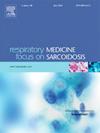Assessment of breathing patterns and voice of patients with COPD and dysphonia
IF 3.5
3区 医学
Q2 CARDIAC & CARDIOVASCULAR SYSTEMS
引用次数: 0
Abstract
Introduction
There is a noticeable lack of studies relating to voice, breathing and how they relate to each other in patients with voice or respiratory diseases. Therefore, the aim of our study was to assess and compare the breathing pattern and voice variables in people with voice and respiratory disorders.
Material and methods
The research was conducted on a group of 61 persons, including 16 patients with chronic obstructive pulmonary disease (COPD), 15 patients with dysphonia and 30 healthy persons. Breathing pattern and voice variables were assessed in relaxed sitting position. The breathing parameters was evaluated separately for upper and lower chest using the respiratory inductive plethysmography. The recording of acoustic speech signal was performed using a dynamic stage microphone with a preamplifier and a digital signal recorder. The acoustic signal was further analysed by evaluating four parameters: Jitter, Shimmer, HNR and MFCC.
Results
In the sitting position, people with dysphonia and COPD had longer and deeper exhalations and deeper breaths than healthy subjects, regardless of the assessed track, however in the subjects with COPD higher for the abdominal track and for dysphonia subjects in thoracic track were observed. Subjects suffering from dysphonia were characterized by lower voice power and pitch and more distortions in the speech signal compared to healthy subjects, whereas both dysphonia and COPD patients had statistically significantly lower voice frequency compared to the control group.
Conclusion
Subjects with COPD made greater use of the diaphragmatic track in sitting position, whereas subjects with dysphonia used the thoracic track to a greater extent. Stronger correlations between voice and respiratory parameters for the abdominal track exist in people with voice or respiratory dysfunctions than in healthy subjects.
求助全文
约1分钟内获得全文
求助全文
来源期刊

Respiratory medicine
医学-呼吸系统
CiteScore
7.50
自引率
0.00%
发文量
199
审稿时长
38 days
期刊介绍:
Respiratory Medicine is an internationally-renowned journal devoted to the rapid publication of clinically-relevant respiratory medicine research. It combines cutting-edge original research with state-of-the-art reviews dealing with all aspects of respiratory diseases and therapeutic interventions. Topics include adult and paediatric medicine, epidemiology, immunology and cell biology, physiology, occupational disorders, and the role of allergens and pollutants.
Respiratory Medicine is increasingly the journal of choice for publication of phased trial work, commenting on effectiveness, dosage and methods of action.
 求助内容:
求助内容: 应助结果提醒方式:
应助结果提醒方式:


